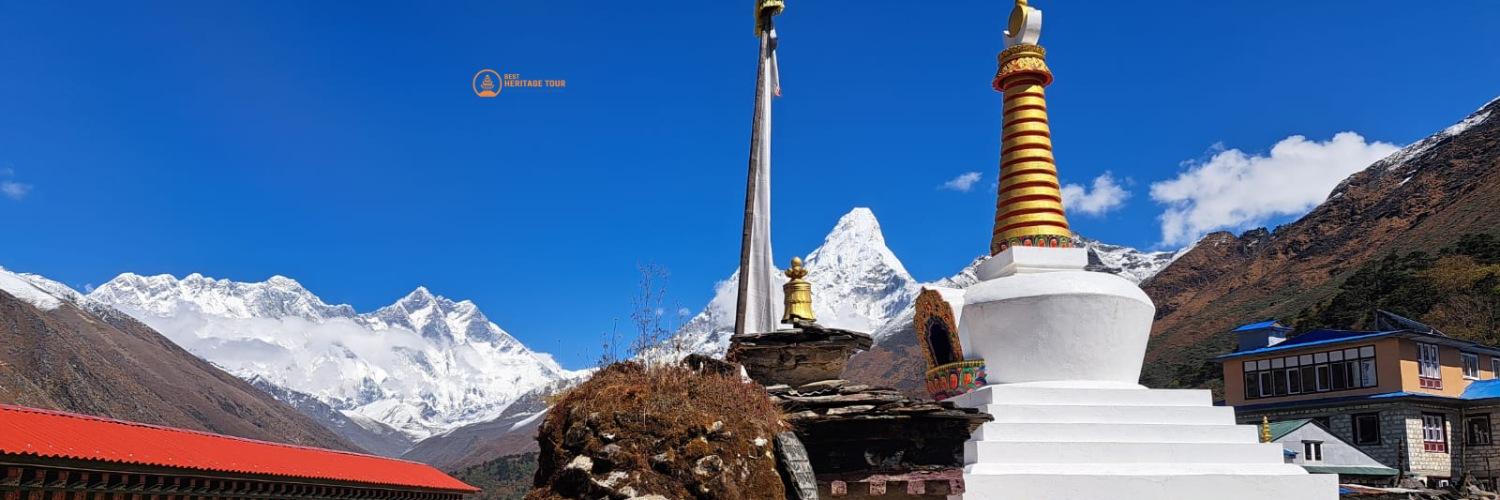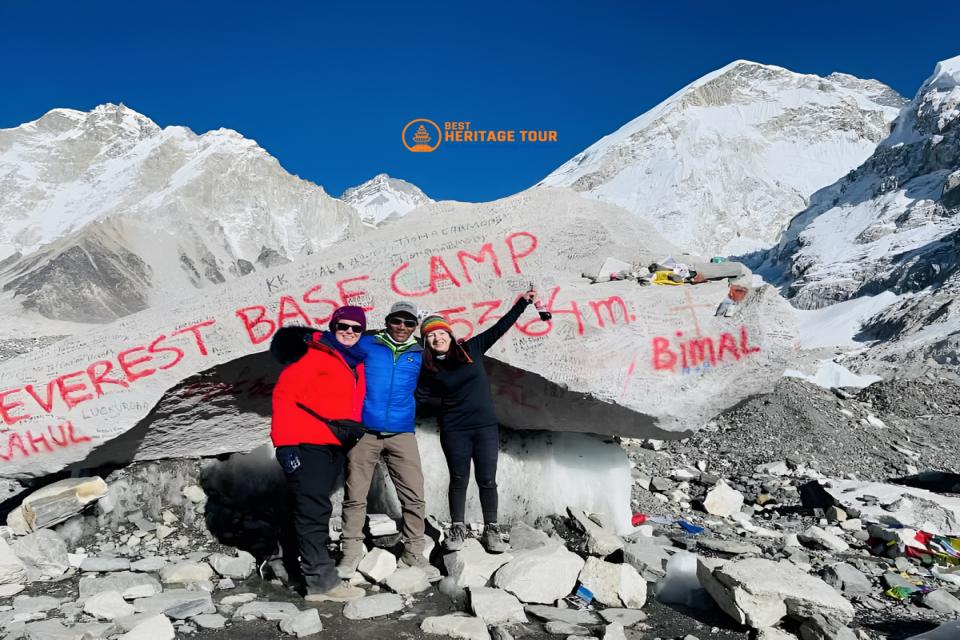The Everest Base Camp (EBC) Trek is one of the world’s most iconic trekking adventures, attracting travelers seeking breathtaking Himalayan scenery, Sherpa culture, and the thrill of high-altitude trekking. While the journey is unforgettable, one question that concerns trekkers is: how cold does it get at night in guesthouses along the route?
Nighttime temperatures along the trek can vary dramatically depending on altitude, season, and weather conditions. This guide provides detailed insights on night temperatures at key stops, practical tips for staying warm, and essential gear recommendations to ensure a safe and comfortable trek. Additionally, it highlights why trekking with Best Heritage Tour makes the journey smoother and more enjoyable.
Nighttime Temperatures Along the EBC Trek
The EBC trek spans from Lukla (2,860 m) to Everest Base Camp (5,364 m), passing through various villages and acclimatization stops. Nights get progressively colder as you ascend:
Lukla (2,860 m)
-
Night temperatures: 0°C to 5°C (32°F to 41°F)
-
Conditions: Relatively mild; guesthouses are comfortable and heated stoves are available in some lodges.
Phakding (2,610 m)
-
Night temperatures: -1°C to 4°C (30°F to 39°F)
-
Conditions: Small lodges with shared rooms; warm bedding is often sufficient with light layers.
Namche Bazaar (3,440 m)
-
Night temperatures: -5°C to 0°C (23°F to 32°F)
-
Conditions: Cold, especially in early morning; stoves or small heaters may be available in mid-range lodges.
Tengboche (3,860 m)
-
Night temperatures: -8°C to -3°C (18°F to 27°F)
-
Conditions: Rustic lodges; nights can feel very cold due to altitude and wind exposure.
Dingboche (4,410 m)
-
Night temperatures: -12°C to -6°C (10°F to 21°F)
-
Conditions: Thin air and minimal heating in lodges; a high-quality sleeping bag is essential.
Lobuche (4,910 m)
-
Night temperatures: -15°C to -8°C (5°F to 18°F)
-
Conditions: Guesthouses are basic, often unheated; layering and hot water bottles are recommended.
Gorak Shep (5,170 m)
-
Night temperatures: -18°C to -10°C (0°F to 14°F)
-
Conditions: The highest night stop before EBC; very cold, especially in winter.
Observation: Regardless of the season, nights above 4,000 m require careful preparation for cold.
Seasonal Variations
Spring (March-May)
-
Nights range from -10°C to 0°C, depending on altitude.
-
Moderate temperatures make trekking easier; clear skies provide stunning views.
Autumn (September-November)
-
Nights range from -10°C to -5°C above 4,000 m.
-
Post-monsoon period with crisp air and excellent visibility; considered one of the best trekking seasons.
Winter (December-February)
-
Nights can plummet to -20°C to -25°C at higher stops.
-
Requires maximum insulation, extra warm gear, and careful acclimatization.
-
Fewer trekkers, making the experience more serene.
Summer/Monsoon (June-August)
-
Nights slightly warmer, -5°C to -10°C, but the region can be wet and muddy.
-
Clouds and occasional rain reduce nighttime cold slightly.
Guesthouse Conditions Along the Trek
Guesthouses along the EBC trek are basic, rustic, and designed for trekkers, not luxury travelers:
-
Rooms: Small, shared, with thin mattresses and minimal furnishings.
-
Heating: Often limited or absent; some lodges use small stoves.
-
Blankets: Provided, but may not be sufficient in extreme cold.
-
Bathrooms: Shared, often outside, with cold running water; some may require extra payment for hot water.
Tip: Nights can feel almost as cold indoors as outdoors, so proper gear is essential.
How to Stay Warm During the Trek
1. Insulated Sleeping Bags
-
Winter: -20°C sleeping bag recommended.
-
Spring/Autumn: -10°C sleeping bag sufficient.
-
Mummy-shaped sleeping bags provide maximum heat retention.
2. Thermal Clothing
-
Base layers, wool socks, fleece jackets, and down jackets.
-
Layering helps trap body heat efficiently.
3. Hot Water Bottles
-
Fill with hot water before sleeping; place inside the sleeping bag for extra warmth.
4. Hand and Foot Warmers
-
Chemical or rechargeable warmers prevent frostbite and numbness.
5. Hydration and Nutrition
-
Eat warm meals and drink tea or soups before bedtime to boost body warmth.
6. Head and Neck Protection
-
Wear hats, balaclavas, or scarves while sleeping to minimize heat loss.
Recommended Gear List
-
Insulated sleeping bag (-20°C for winter)
-
Thermal base layers (top and bottom)
-
Wool or synthetic socks
-
Down or fleece jackets
-
Hat and balaclava
-
Gloves or mittens
-
Hot water bottles
-
Hand and foot warmers
-
Sleeping bag liner for extra insulation
Pro Tip: Keep extra dry socks and gloves, as moisture can make nights unbearably cold.
Benefits of Trekking with Best Heritage Tour
Booking your EBC trek with Best Heritage Tour ensures:
-
Guesthouses with maximum comfort and warmth, carefully selected along the route.
-
Experienced guides who provide advice on staying warm and safe at high altitudes.
-
Hot meals, tea, and hydration available at each stop, boosting comfort and energy.
-
Permit management and logistics handled professionally, reducing stress for trekkers.
With Best Heritage Tour, you can focus on the adventure and scenery without worrying about extreme cold nights.
Conclusion
Nighttime temperatures on the Everest Base Camp Trek can be extreme, especially above 4,000 m. From Lukla to EBC, guesthouses are basic and often minimally heated, making preparation essential.
By packing appropriate gear, layering clothing, using hot water bottles, and staying hydrated, trekkers can enjoy their journey safely and comfortably. Booking with Best Heritage Tour guarantees well-selected accommodations, expert guidance, and a worry-free trekking experience, letting you focus on the breathtaking Himalayan landscapes, Sherpa culture, and the thrill of reaching Everest Base Camp.
Book Your Everest Base Camp Trek Today
Phone: +977-9851149197 / +977-9810043046
Email: info@bestheritagetour.com / bestheritagetour@gmail.com
Website: www.bestheritagetour.com
Office: Thamel Marg, Kathmandu, Nepal
Author: Best Heritage Tour
Date: 25th August, 2025


